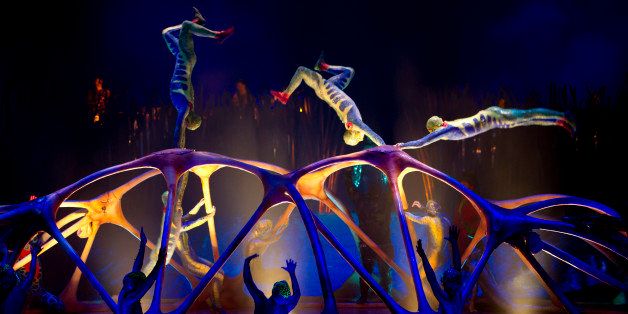
In the darkness under the large tent in Queens, I am suddenly a five-year-old again. Well, maybe not so suddenly. You see I tend to feel this way when I'm watching a Cirque du Soleil show, and their collaboration with Robert Lepage, Totem, is no exception. The piece is inspired by myths of origin and concepts of human progress, though you need not concentrate on these too much, as the amazing Cirque performers could astound in any costumes and context.
This is my third experience with Cirque du Soleil, my other two being La Nouba and last year's Zarkana, and each time I feel as though the "theme" is really more about design than anything else. This is not a critique; Cirque has an amazing design team, and their ability to make a series of virtuosic performers and acts into a unified whole is impressive. A great team of designers joins Cirque artistic directors Guy Lliberté and Gilles Ste-Croix, who founded the Canadian company in 1984. With the aid of Cirque's history of artistic dazzle and Lepage's aesthetically beautiful directing style, Totem is definitely circus chic.
Though it is in a big tent and has popcorn and acrobats, Totem isn't just for families. Don't hesitate to bring the kids, though there is quite a bit more romance and sensuality in this production than the other Cirque pieces I have seen. But the true unifying factor for this audience is the shared desire for awe. As I sat there my heart beat fast, I held my breath, I shook my head in disbelief, and I enjoyed the sheer pleasure of watching people do the impossible.
And impossible is exactly what some of these acts seem to be! Certainly they all start off in a standard enough way: two women spinning rugs in their hands or a group of women on unicycles. Yet they all increase in intensity until the performers on stage are accomplishing feats that you didn't know the human body was capable of doing: balancing on each other as they spin rugs on multiple hands and feet, unicycling and catching bowls on their heads. The most amazing this about this arc is how much the audience is rooting for the performer by the time we get to see the most difficult parts of the act. This is a palpable feeling under the tent in Totem, and it's one of the most infectious things about going to a Cirque du Soleil show.
I should mention something interesting about this particular theme, and that is the way in which culture and ethnicity is approached. As I said before, the themes of these shows tend not to be overly important. There is very little spoken text, and so a majority of the "story" of these shows tends to be revealed through costumes, music, and interlude scenes.
Here the costumes and music had a Canadian Indian theme, though there were also costumes that seemed to suggest "Africa" and "Asia." I put these in quotes because they were specifically nonspecific. At first I was worried about the ways in which these exoticizing costumes would influence my interpretation of the production. But then I realized that the whole point of Cirque du Soleil is about the specific bodies of the performers in front of you. You might not be able to see his or her face or to be able to identify his or her ethnic background, but you know how to recognize each bodily skill. You can identify his or her body, and these trained individuals are unique, even when dressed alike. In this way, the generalization of culture and ethnicity seemed to fade into the simultaneously specific and general statements being made about the human body.
Actually, the most stereotypical cultural portrayal comes from the Italian tourist who entertains us during the interludes. This performer is very clown-like, and he is playing a stock character, of course. The interludes are always the least interesting aspects of the shows for me, but they are still amusing and they again increase the anticipation of the next feat of acrobatics, juggling, or some other impressive skill.
If you want a sure bet for entertaining anyone from a visiting friend or relative to a theatre enthusiast, Totem is a crowd-pleaser. As I said before, this would also be a great choice if you have friends or relatives who do not speak much English. But whoever you are, I think everyone should see one show in which the performers expand your notion of what's humanly possible. If you haven't seen Cirque du Soleil before, there's an opportunity to accomplish that goal right here in New York.
